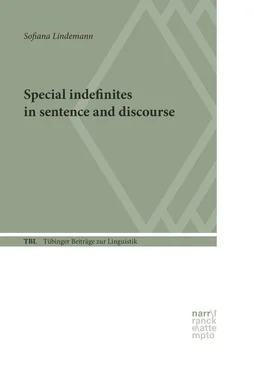1 ...6 7 8 10 11 12 ...15
| (6) |
Paul 1met Ana 2in the park. He 1/ the boy 1was enthusiastic to meet the girl 2/ her 2again. |
Based on a vast corpus analysis of English and Hebrew texts, Ariel (1988, 1990) investigated the distribution of different types of referring expressions, which were eventually ranked on a scale of accessibility, as illustrated in (7). The types of referring expressions are ranked on a continuum, ranging from highest accessibility markers at one end, which are the briefest and least informative forms (e.g. zero anaphors, pronouns), to lowest accessibility markers at the other end, which are the most informative and most elaborate forms (i.e. full names, distal demonstratives).
| (7) |
The Accessibility Marking Scale by Ariel (1990: 73) |
|
Full name + modifier < Full ('namy') name < Long definite description < Short definite description < Last name < First name < Distal demonstrative + modifier < Proximal demonstrative + modifier < Distal demonstrative < Proximate demonstrative < Distal demonstrative < Proximate demonstrative < Stressed pronoun + gesture < Stressed pronoun < Unstressed pronoun < Cliticized pronoun < Reflexive < Gap < Zero |
Despite the fact that quantified and indefinite nominal phrases represent one of the most common means to introduce new referents in a given discourse, Ariel (1990) does not include this type of referring expressions on her scale to signal an even lower accessibility than full proper names and definite descriptions. A first reason for their exclusion might be the fact that indefinite descriptions represent new information and thus lack an antecedent. When establishing the accessibility of a referent, its discourse history is of utmost importance for Ariel. More concretely, the two textual characteristics “distance” and “unity” of any anaphoric expression can be determined only in a backward-looking manner, by analysing the preceding discourse in connection with an antecedent. As indefinite noun phrases do not have antecedents, no prediction can be made about their accessibility in terms of distance and unity. A second possible reason for the exclusion of indefinite noun phrases from the Accessibility Marking Scale is the non-referential status sometimes attributed to this type of noun phrases (Russell 1919, Evans 1977, 1980). However, as Lewis (1979: 180) puts it, indefinite noun phrases may nevertheless raise the salience of particular individuals “to pace the way for referring expressions that follow”. In sum, even though Ariel’s theory (2001) cannot make any predictions with respect to the accessibility of a referent introduced by an indefinite noun phrase, we will nevertheless keep in mind that accessibility is a graded phenomenon and that different factors seem to be at work in determining the accessibility of a particular referent. In section 2.3.3 we discuss a number of factors that have been shown to bias language users’ expectations about who will be mentioned next and what referent is more likely to be pronominalized.
Before I introduce the notion I will work with to explain the alternations found with indefinite noun phrases in English, German and Romanian, I will introduce another account to accessibility in terms of topicality, which focuses on entities that are going to be topical in the upcoming discourse. The two models that are discussed in what follows compute the accessibility of a referent by combining the status retained by an entity in the previous discourse with the forward-looking potential of this entity.
2.3 Accessibility as topicality
The notion of topic or topicality was in the attention of linguists and psycholinguists for a long time. For Chafe (1976), topics represent the amount of old information given in a discourse, while Reinhart (1982) describes topics in terms of “aboutness”, as discourses seem to be more about certain referents than about others. The traditional distinction between subjects and predicates made exactly this type of difference: between an entity the sentence was about (the subject referent) and another part that predicated on it (the predicate). Givón (1983) and the proponents of Centering Theory (Passoneau 1994, Grosz, Joshi and Weinstein 1995, Walker, Joshi and Prince 1998) offer two distinct but related referential management models in terms of topicality. Contrary to their forerunners’ view (e.g. Reinhart 1982), topicality is not paired with an atomic element within each clause, but is conceived as a graded notion. In comparison to the approaches to accessibility in terms of (cognitive) activation discussed in the previous Sections, which are mainly concerned with the amount of attention allocated to a particular referent in the preceding utterance, employing a backward-looking perspective, the proponents of the view of accessibility as topicality focus on entities that are going to be topical in the upcoming discourse, thus, on the forward-looking potential of referents. We will discuss Givón’s distance model and the Centering Theory in what follows.
2.3.1 Givón’s distance model
For Givón (1983), the amount of importance allocated by speakers to different referents is decisive for determining their topicality. He assumes that all referents are more or less topical from the perspective of production and that (i) thematically more important (topical) referents tend to be picked up more often in the discourse, and that (ii) the more recurrent a referent is, the less descriptive material is needed to pick it up. In other words, less explicit types of referring expressions will be used for recurrent or frequently mentioned referents. Bearing these two assumptions in mind, Givón (1983) proposes two measures of importance or topicality, which is not measured directly, but by referential continuity in two opposite directions, namely in the preceding and in the upcoming discourse.
The first measure method or indicator of topicality is anaphoric continuity or referential distance, which investigates a referent’s discourse history by exploring whether the referent has an antecedent, and if so, in which sentence in the preceding discourse it occurs. The smaller the distance between antecedent and anaphor, the more topical the referent is. This backward-looking measure corresponds directly to Ariel’s (1988, 1990) textual factor “distance”, which is also concerned with the distance between anaphor and antecedent in terms of number of intervening sentences between two mentions of a referent. The second indicator of topicality proposed by Givón (1983) is cataphoric continuity, which measures the persistence of a (topical) referent in the subsequent discourse. The prediction is that the more often a referent is picked up in the subsequent discourse, the more topical it is, thus reflecting the speaker’s intentions about the role that entity will play in the continuing discourse. The advantage of Givón’s (1983) model of topic continuity is that it combines forward-looking and backward-looking methods to measure the topicality of a referent in a given discourse. This model can be applied to explore the accessibility of referents introduced by different types of referring expressions, including indefinite noun phrases, which generally lack an antecedent and thus have no anaphoric force. Givón (1983) furthermore observes that potential interference , which refers to the copresence of more referents, which are similar in animacy or semantic and syntactic prominence, may dampen the topicality of a given referent. The prediction is that when many competing referents are present in a text, a pronoun referring back to one of them is (generally) dispreferred, to avoid ambiguity.
In a cross-linguistic analysis of texts, Givón (1983) crossed the two factors determining or indicating the topicality of referents (i.e. referential distance and topic persistence) with different syntactic, semantic and phonologic coding devices to determine topical constituents. The results of his findings are presented in form of a gradable scale, as illustrated in (8).
Читать дальше












